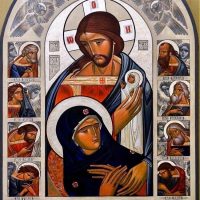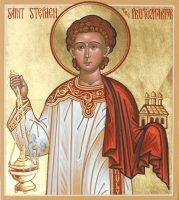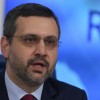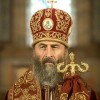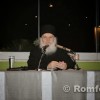Mother Maria (Egereva) has been serving in the icon painting studio of St Elisabeth Convent, Minsk for about ten years. She has also been teaching in the school of icon painting of the Convent since 2009.
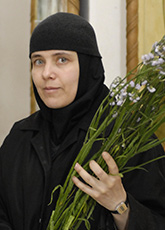
Nun Maria (Egereva)
Mine was a regular Soviet family, and I studied at a regular Soviet school. However, my soul was looking for the meaning in life even when I was a child. I just could not understand why everything went as it did. My mum often suffered from various diseases, and I worried about her and thought why it had happened. When I grew older, our country began to change, the propaganda was stopped, many new things appeared, not always they were related to church (take astrology or Buddhism, for example). I tried all of them before I eventually turned to Orthodoxy.
Why did you turn to Orthodoxy?
I was interested in Orthodoxy just like in everything else. I remember the moment when the life became unbearable. My soul understood that there was nothing that could help me except confession. I knew there was such thing as confession but I was afraid of approaching a priest and telling him about my sins. When the life is tough you realize that neither nature nor astrology can help and support you, but faith and God only.
How did you learn about the Sisterhood?
I attended Ss Peter and Paul Cathedral. The first person I saw there was Father Andrew (Priest Andrew Lemeshonok, today Archpriest Andrew, is the spiritual father of the Convent and the Sisterhood in honour of St Elisabeth). He was singing an Akathist in honour of the “Inexhaustible Chalice” icon of Mother of God. I also visited the Akathist to Saint Martyr Elisabeth on Sundays. I loved to see the sisters in their white garments. That was how I came here.
I collected donations at first. I remember that I was the best and the most graceful period in my life. Later, I came to the icon painting studio and into the Convent…
How did you become an icon painter?
Everybody in the Convent kept telling me that because I was an artist by diploma, I should paint icons. I did not want to do that at first. When I started going to church, I threw away everything related to my previous life, including art albums. Now I pity that because many of these books would be necessary today.
It seemed to me that icon painting is something extremely hard to do. I was so satisfied with my relationship with God that I even wanted to be a cleaner but the Lord arranged it in a different way.
Why did you choose to be a monastic?
I attended talks with Fr Andrew, they were held in Ss Peter and Paul Cathedral rather than the Convent. He would bring us books by Father Sophronios, and the story of Elder Ephraim. These books moved me deeply. First I thought that monasticism is too great for me. However, there was a moment when I suddenly decided to become a nun and I have never questioned that decision since.
What is the most important for an icon painter? Can you share your experience? Is painting icons somehow connected to one’s inner life?
There are different periods in one’s life. It is not always that one feels great God’s grace. Sometimes one’s heart is heavy and the person suffers from pangs of conscience. One has to have a peaceful and tranquil mood in order to begin painting an icon. However, my personal experience is that even when my soul is troubled and I start painting an icon, the Lord acts and cures my soul with that icon. The main thing I can share is that it is not me who paints an icon; the icon is somehow painted because when one paints an icon he calls for God and has relationship with Him.
First of all, one ought to love what he does. An icon painter cannot be anything else. He has to devote all his life to icon painting.
How do you create the images?
When I get to know what I am to paint, I begin my preparation by reading about that saint. I do not paint anything on that stage but I gradually grow to understand what the icon must be like. I draw sketches and show them either to our Father Andrew, if the icon is for our church, or to the person who asked me to paint the icon.
What do you feel when the work is done?
I feel happy when I finish my work. I have been painting large icons recently, and each one of them takes about a month to paint. Sometimes icons are related to one another so I have to paint them for several months. For instance, I had to spend almost four months painting an icon of the Royal Family.
Do you have a special style of icon painting that you learned from experience?
I have come to the conclusion, especially when I started teaching at the school of icon painting, that I do not know anything and that I have to learn everything from the very beginning. Lately, I have been working like this: I take an ancient icon or tablets and try to copy its lines and colours. There is a very beautiful icon of Saint Sergius of Radonezh in the Museum of Andrew Rublev in Moscow. Now I try to copy it. We travelled to Moscow with our school and tried to copy the icons we saw in the museum. I think I lack knowledge because what I have learned is just a part of it.
What icon do you consider to be an ideal, an example for you?
Saint Andrew Rublev’s icons, naturally. Not even his style, but his depth and his serenity. There was a lesson in our school of icon painting where we discussed light in icons. Light was very important for all icon painters of the XIV and XV centuries. This was the time when St Gregory Palamas wrote about the Divine Light of Tabor. This found its reflection in the painting by Theophan the Greek, Andrew Rublev, and Dionisius, but each one of them had a different way of showing it. Theophan the Greek has the light burning like flames. The light in the icons of Andrew Rublev is peaceful and pouring from the inside. The light in the icons by Dionisius is unmatched, his colours are majestic and light. Icons painted by Dionisius are often said to be like music. There was a decline in the Russian art of icon painting after Dionisius. The XVII, XVIII, and XIX centuries are far from being the best times for the Russian icon.
Is there a present-day icon painter who is an example for you?
Speaking from the technical point of view, Deacon Sergius is such an example, I think I can learn a lot from him. There are many talented people in our workshop so I can learn something from everyone. We regularly hold exhibitions of the icons we paint, and some of these icons are just marvellous.
We know an amazing person – Father Igor Latushko, he is a priest and an icon painter. Certainly, we are glad to meet him each time. Deacon Sergius used to learn the art of icon painting from him. Father Igor does not teach the technology first and foremost, he primarily teaches the attitude towards the world and the icon. People differ: there are fervent and hot-tempered personalities but he is peaceful and calm. We all like it when Father Igor comes to our studio.
Have you had a feeling that some icons are easier to paint than other icons?
Some icons are easier to paint, some are more difficult. I remember that I would quickly and easily paint icons just after my tonsure. I consider it to have clearly been an act of God. However, the Lord acts anyway, and I am delighted to paint any icon.
Icon painters say that faces are difficult to paint sometimes. Do you think it has something to do with the icon painter’s spiritual life?
It is hard to tell. Sometimes it is difficult from the technical point of view. Take a typical situation: when you paint for a long time without stopping, the layers do not dry up properly, and, since there are many of them, they haze, as icon painters call it. On the other hand, each person has different periods in his life. For one person, painting is easy right from the start, while for another person, things are much more difficult. Sometimes years may pass without any sign of success, and the person gets upset. However, he should not lose hope. As far as one’s spiritual state is concerned… Well, it has something to do with icon painting. When the icon is good and the artist becomes proud, his next icons will not be good unless he humbles himself.
Is it necessary for an icon painter to pray to the saint he portrays or is there a different way?
One has to persevere in the prayer of the heart. When it is quiet around you and nobody distracts you, you can dive deeper, perhaps…
Who is your favourite saint?
Why?
There are many events in my life associated with St Sergius, for instance, my coming to the Church, and icon painting because it was him who inspired St Andrew Rublev to paint the icon of the Holy Trinity. He is humble. I also consider St John the Baptist and St Tikhon to be my favourite saints.
How is your coming to the Church associated with St Sergius?
The life of St Sergius was the first spiritual book I read. The first holy place I had a pilgrimage to was Holy Trinity-St Sergius Lavra where I came on the patron saint’s day of St Sergius. His parents did not want him to go to the monastery. My parents did not want me to become a monastic as well. I came to the Convent in autumn, on the day of Saint Sergius.
We were dreaming of having a particle of his relics in our Convent. Once we went to the Holy Trinity-St Sergius Lavra and they gave us a particle of his relics. This was God’s mercy!
Some people in the icon painting studio are newcomers to the church, aren’t they?
All our icon painters are active church members. One girl was baptized during her study at the school of icon painting. I do not think that the art of icon painting will be of any interest to an unbeliever. Even if a person does not attend church, the icon will lead him to God.
Source: obitel-minsk.by












